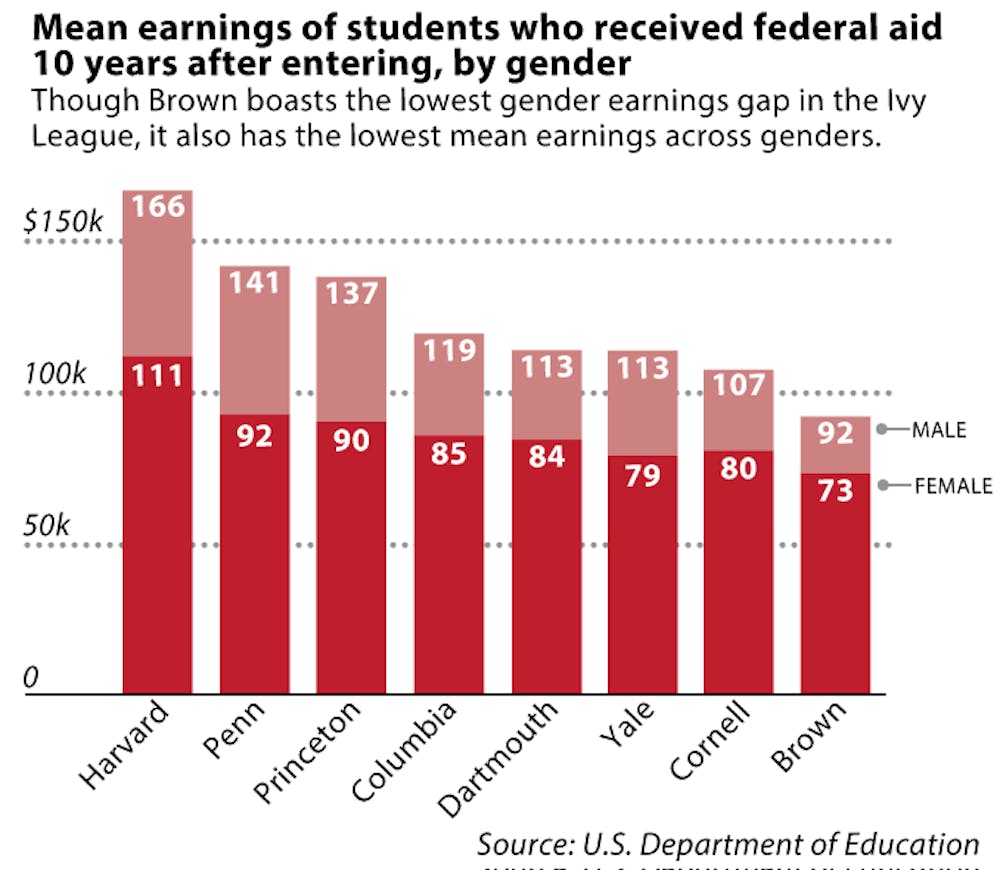Brown attendees who received federal financial aid have the lowest median earnings in the Ivy League 10 years after entering the University, and female Brown attendees make almost $20,000 less on average than their male counterparts, according to College Scorecard.
College Scorecard, a new federal tool launched by President Obama, seeks to educate Americans on the value of thousands of colleges nationwide through statistics on topics including financial aid, graduation rates and alumni salaries.
College Scorecard shows that Brown students who were on federal financial aid earn a median salary of $59,700 10 years after matriculating to the University. Though well above the national average of $34,343, Brown attendees’ median earnings are the lowest in the Ivy League. Harvard tops the list at $87,200, while Yale places seventh at $66,000.
Relatively lower earnings after leaving Brown can be attributed to the types of jobs to which many Brunonians gravitate. A look at the job distribution for the class of 2014 at Ivy League schools shows that a smaller share of Brown alums entered finance and consulting — two typically high-paying industries.
In a survey by the Center for Careers and Life After Brown, 21 percent of Brown’s class of 2014 reported being employed in either finance or consulting. This figure is noticeably lower than the 41 percent of Penn attendees and 37 percent of Cornell attendees who work in these areas. Cornell alums who entered finance earned a mean salary of $66,981, while those who went into consulting made around $62,790.
But a significantly higher percentage of Brown alums choose to work in the non-profit sector. “Some of our information on recent alumni suggests that, in comparison to our peers, Brown graduates are more likely to work in the non-profit sector, which could be another part of the explanation,” wrote Tracy Barnes, director of institutional research, in an email to The Herald. “This is even more often the case for the graduates who were recipients of Pell Grants.”
Approximately 30 percent of Pell Grant recipients and 21 percent of non-Pell Grant recipients work at nonprofits after graduation, Barnes wrote. As College Scorecard only takes into account the median earnings of students who received financial aid, a high percentage of Pell Grant recipients choosing to work in nonprofits greatly affects the overall number reported on a university’s profile.
“I love that our students are passionate about helping people, helping communities or just doing something that’s for the greater good,” said Matthew Donato, director of CareerLAB, adding that CareerLAB programs such as “Careers in the Common Good” provide resources and access to alums for students exploring careers in nonprofit organizations. “It’s really great that our students want to take the super strong education that they get here and apply it to fixing problems in a very direct way.”
College Scorecard also reveals a stark wage gap between male and female alums at Brown and many of its peers. On average, female Brown attendees earn $18,800 — or 80 percent — less than their male counterparts. While Brown has the smallest gender wage gap among all Ivy League schools, this gap tends to increase across the Ivies as both genders earn more. There is a $54,600 discrepancy between the earnings of female and male Harvard attendees, and Yale women earn around 69 percent of what Yale men earn.
There are several potential explanations for the persistence of this wage gap across schools. In general, women are more likely than men to take a leave from work or reduce their hours in order to care for families, according to the Pew Research Center.
Another potential explanation lies in the ratio of male to female students in science, technology, engineering and math fields.
STEM graduates frequently earn more than other graduates straight out of college, largely because fields such as engineering and computer science are directly applicable to jobs in the market, said David Targan, associate dean of the College for science and director of the Science Center. With a degree in one of those two areas, “it is pretty likely that you can start with a job that’s relatively well paying,” he said. “You don’t necessarily need to go to graduate school in order to get a job.”
Women are typically underrepresented in science and math departments, especially in the physical sciences, “a trend that has been in evidence for decades” and is “true nationally,” Targan said. Only 32 percent of the sophomores who declared concentrations in engineering last semester and 28 percent of those who declared concentrations in computer science were female, according to the Office of the Registrar.
“It can be difficult for a female student to be in a class where they’re in the minority,” Targan said, adding that often women interested in STEM fields do not feel they have faculty or peer role models. The University has programs such as Women in Science and Engineering and Women in Computer Science that pair female STEM students with mentors with the aim of breaking down the stereotypes surrounding female science and math concentrators.
It is vital that universities work on addressing the gender stereotypes perpetuated in STEM fields, Targan said. One place that universities can begin to enact change is the hiring process: STEM departments need to ensure that they attract a diverse faculty in terms of both gender and race, she said.

ADVERTISEMENT




